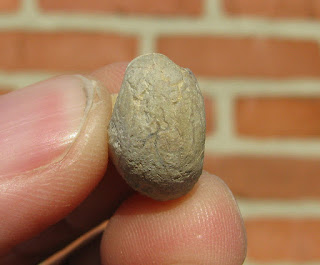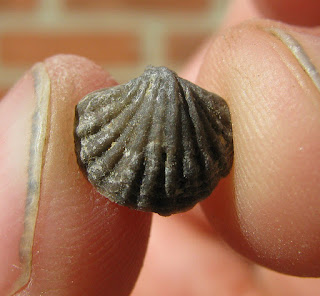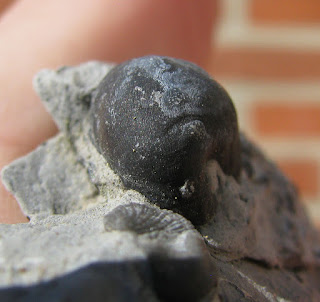I really like the look of this next Brachiopod. It's a Sellithyris sella from the Aptian stage of the Cretaceous (found at the Clape Massif near Narbonne, France) that has part of the shell replaced by the "mineral" Beekite (which is a variety of Chalcedony, itself a variety of Quartz). That and the colors of the shell give it a lot of visual interest beyond the shell itself.
Sellithyris sella is a terebratulid brachiopod that is oval in shape when viewed from the top or bottom.It has a beak with a round foramen on the pedicle valve. Both valves are smooth and convex with a simple "w" shaped fold and sulcus structure on the anterior margin.
Pedicle valve
This fossil reminds me of another terebratulid brachiopod called Cererithyris arkelli but that species lived during the Bathonian stage of the Jurassic, about 50 million years apart.
Sunday, August 30, 2015
Friday, August 28, 2015
Two gastropod steinkerns from the Lime Creek formation of Iowa
I found two gastropod steinkerns in my collection of Lime Creek Formation fossils from Rockford fossil Park in Iowa. They caught my attention as I was sorting the fossils I have from there to find duplicates I could send to a friend in Germany.
The first specimen is a Bellerophon sp. steinkern. Gastropods of this genera generally have a wide flaring opening to the body chamber and the shell whorls imbricate (directly overlap) upon themselves. The flared portion of the shell is missing on this steinkern but the whorls are imbricated.
Anterior view
Left side profile
Posterior view
Dorsal view
Ventral view
The other steinkern specimen is a gastropod called Floydia sp. whose whorls are not imbricated but appear stacked on top of each other. As this is an internal steinkern it is impossible to tell if the genera is correct much less determine the species.
Left profile
Anterior view
Dorsal view
Ventral view
Both of these specimens come form the late Devonian aged Lime Creek formation (Fransian stage).
The first specimen is a Bellerophon sp. steinkern. Gastropods of this genera generally have a wide flaring opening to the body chamber and the shell whorls imbricate (directly overlap) upon themselves. The flared portion of the shell is missing on this steinkern but the whorls are imbricated.
Anterior view
Left side profile
Posterior view
Dorsal view
Ventral view
The other steinkern specimen is a gastropod called Floydia sp. whose whorls are not imbricated but appear stacked on top of each other. As this is an internal steinkern it is impossible to tell if the genera is correct much less determine the species.
Left profile
Anterior view
Dorsal view
Ventral view
Both of these specimens come form the late Devonian aged Lime Creek formation (Fransian stage).
Wednesday, August 26, 2015
Coelospira concava or Atrypina imbricata brachiopod from the Kalkberg formation of New York
This is the last fossil that I am profiling from the Kalkberg formation for now. I'm very surprised at the number of species that I found from this formation considering that I have only visited it once and only at a single roadcut. The honor of being last goes to a mystery brachiopod. The shell is semielliptical with a convex pedicle valve and concave brachial valve. Both valves have very strong plications but no fold/sulcus structure. There are prominent growth lines visible towards the edges of the margins. The pedicle valve appears to have a beak and umbo.
Pedicle valve
Anterior
Brachial valve
Posterior
Profile
Hall lists two species that look similar to the above fossil, Leptocoelia concava (since updated to Coelospira concava) and Leptocoelia imbricata (Since updated to Atrypina imbricata), in the "Paleontology of New York", Vol 3, pg. 245-246, pl. 38, fig. 1-13. Based on the pictures in that volume I am inclined to call my fossil Atyrpina imbricata due to the presence of the growth lines which is indicative of the species.
This specimen was collected from the Kalkberg formation (Devonian, Lockhovian to Pragian stage) at a roadcut near Schoharie, NY.
Pedicle valve
Anterior
Brachial valve
Posterior
Profile
Hall lists two species that look similar to the above fossil, Leptocoelia concava (since updated to Coelospira concava) and Leptocoelia imbricata (Since updated to Atrypina imbricata), in the "Paleontology of New York", Vol 3, pg. 245-246, pl. 38, fig. 1-13. Based on the pictures in that volume I am inclined to call my fossil Atyrpina imbricata due to the presence of the growth lines which is indicative of the species.
This specimen was collected from the Kalkberg formation (Devonian, Lockhovian to Pragian stage) at a roadcut near Schoharie, NY.
Monday, August 24, 2015
Paleschara or Leioclesma bryozoans from the Kalkberg formation of New York
These little bryozoan "chips"were interesting to find and I'm trying to figure out what genera they are. They bear a resemblance to Paleschara sp. but they are not encrusting a shell, which is how I find them most often. they could also be another genera called Leioclesma sp. which looks similar but does not have the encrusting habit. Both of the below specimens did start out colonizing a small hard surface with the first specimen growing over an ossicle from a crinoid stem.
Specimen #1 - Dorsal surface
Profile view showing just how flat this fossil is.
Ventral surface
Specimen #2 - It's not as clear as to what the second specimen settled on. It could be a fragment of another bryozoan or possibly an ostracod carapace. Dorsal surface
Ventral surface
Both of these specimens were collected from the same roadcut near Schoharie, NY from the Kalkberg formation (Devonian, Lockhovian to Pragian stage).
Specimen #1 - Dorsal surface
Profile view showing just how flat this fossil is.
Ventral surface
Specimen #2 - It's not as clear as to what the second specimen settled on. It could be a fragment of another bryozoan or possibly an ostracod carapace. Dorsal surface
Ventral surface
Both of these specimens were collected from the same roadcut near Schoharie, NY from the Kalkberg formation (Devonian, Lockhovian to Pragian stage).
Saturday, August 22, 2015
Platyceras sp. gastropod from the Kalkberg formation of New York
I've found a few gastropod fossils in the Kalkberg formation that are well preserved, which seems to be typical for most NY Devonian material. The below three specimens all appear to be Platyceras sp. with the first two looking very similar to each other.
Specimen #1
Specimen #2 - a part of the shell is broken and missing and that truncates the outer spiral.
Specimen #3 - This specimen is larger than the other two and may just be an older representative of the same species. The coil is covered with matrix so I can't see if it's similar to the other two examples.
All three specimens were collected from the same roadcut near Schohaire, NY from the Kalkberg formation (Devonian, Lockhovian to Pragian stage).
Specimen #1
Specimen #2 - a part of the shell is broken and missing and that truncates the outer spiral.
Specimen #3 - This specimen is larger than the other two and may just be an older representative of the same species. The coil is covered with matrix so I can't see if it's similar to the other two examples.
All three specimens were collected from the same roadcut near Schohaire, NY from the Kalkberg formation (Devonian, Lockhovian to Pragian stage).
Thursday, August 20, 2015
Favosites sphaericus coral from the Kalkberg formation of New York
According to Hall's "Paleontology of New York", Volume 6, pg. 9, pl. VII, fig. 1-12, the specimen below may be Favosites sphaericus. It has very small cells, similar to a bryozoan, but forms hemispherical mound shape and has an epitheca. Here is Hall's original description:
Ventral surface
Profile views of the specimen turned 90 degrees to the right in each succeeding picture
Ventral surface with the epitheca.
The above specimen came from the Kalkberg formation and was found in a road cut near Schohaire, NY. the Kalkberg formation is Devonian in age (Lockhovian to Pragian stage).
Corallum massive, variable in form. Cell tubes polygonal, generally hexagonal;length from 2 to 13 mm. or more; diameter from .25 to .35 mm. On the surface are frequent maculae .5 mm. in diameter, where the cells are larger than the others. Cell walls thin ; smooth or with transverse wrinkles or striae, which sometimes form indistinct nodes at the angles. Septa strong; sometimes distant from each other; at other times quite closely arranged. Mural pores minute, comparatively distant, a single series on each face ,of the tube.Then he follows that paragraph with the following:
This species is very variable in its mode of growth, sometimes occurring in branching forms, with the cell tubes commencing at the centre and gradually curving upward and outward to the surface; others are in hemispherical masses, with a flat base, the tubes radiating from the base to the surface; increasing by interstitial or lateral additions; sometimes in masses formed ofAfter reading that it seems that Hall had some difficulty separating this species from possible bryozoan species, especially when he mentions "cell tubes commencing at the centre and gradually curving upward and outward to the surface". The specimen that I have tentatively identified as F. sphaericus is somewhat weathered and some detail is either missing or obscured by matrix. In general, it has been my experience that small celled masses belonged to Bryozoans while larger celled masses were coral. Without sufficient preservation I can't tell if there are monticules present (which would indicate it is a bryozoan) nor can I examine it in enough detail to look for septa (which would indicate it is indeed a coral). So for now I am sticking with the tentative ID.
successive layers, as if by interruptions in growth. It is also found encrusting crinoid stems and other objects, especially the basal portion of Lepadocrinus, occurring sometimes in layers of not more than 2 mm. in thickness.
Ventral surface
Profile views of the specimen turned 90 degrees to the right in each succeeding picture
Ventral surface with the epitheca.
The above specimen came from the Kalkberg formation and was found in a road cut near Schohaire, NY. the Kalkberg formation is Devonian in age (Lockhovian to Pragian stage).
Tuesday, August 18, 2015
Pelecypods from the Kalkberg formation of New York
Pelecypods in limestone are fairly uncommonly preserved but I do have two examples that I've found in the Kalkberg Limestone near Schohaire. The first is what I believe is an Actinopteria communis based on the radial rays that decorate the shell surface and the "ear" that is typical of the Pterineidae. The shell is incomplete so I don't have too much more detail to work with.
The other is a rough cast that has the shape of a pelecypod but no other diagnostic details that would help to identify it.
The Kalkberg formation is Devonian in age (Lockhovian to Pragian stage).
The other is a rough cast that has the shape of a pelecypod but no other diagnostic details that would help to identify it.
The Kalkberg formation is Devonian in age (Lockhovian to Pragian stage).
Sunday, August 16, 2015
Nucleospira ventricosa braciopod from the Kalkberg formation of New York
I have found only one specimen of the fossil brachiopod Nucleospira ventricosa from the Kalkberg formation but it is somewhat easy to recognize. The shell is oval in shape with a convex pedicle valve and a slightly convex brachial valve. the shell surface appears to be smooth but actually has a number of small bumps where spines would have been attached. No other ornamentation is visible on the shell nor is there any fold/sulcus structure.
Brachial valve
Anterior
Pedicle valve
Posterior
Profile
Compare this fossil to Nucelospira conncinna from the Kashong Shale (Givetian stage of the Devonian). The above fossil was found in a roadcut near Shoharie, NY and came from the Kalkberg formation (Devonian, Lockhovian to Pragian stage).
Brachial valve
Anterior
Pedicle valve
Posterior
Profile
Compare this fossil to Nucelospira conncinna from the Kashong Shale (Givetian stage of the Devonian). The above fossil was found in a roadcut near Shoharie, NY and came from the Kalkberg formation (Devonian, Lockhovian to Pragian stage).
Subscribe to:
Comments (Atom)



















































